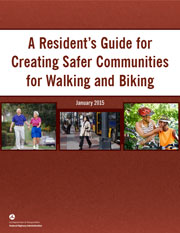A Resident's Guide for Creating Safer Communities for Walking and Biking
Source: Federal Highway Administration (FHWA)

People need and want communities where streets are safe, accessible, and comfortable for all users, including those traveling by car, foot, bike, or mass transit. Streets that are pedestrian- and bicycle-friendly have many benefits, including:
- Safer environments, where you are less likely to be in a traffic collision or get injured.
- Better access to more destinations, providing more choices in how you can get where you want to go without relying on a car.
- More opportunities to be physically active, which can improve your health and overall quality of life.
- Opportunities for everyone, which includes people with disabilities.
It takes the commitment and involvement of many people to build and maintain places that are safe and friendly for walking and bicycling. This guide is designed to be used by anyone looking for ways to improve the safety and comfort of their neighborhood streets, whether they are just beginning to learn about traffic safety or are already part of an established community safety or advocacy group. Residents can make a difference by raising awareness of pedestrian and bicycle safety issues and pushing for change.
This guide provides examples from other communities working to improve pedestrian and bicycle safety. It includes ideas and resources to help residents learn about issues that affect walking and bicycling conditions, find ways to address or prevent these problems, and promote safety for all road users. The Resource Sheets at the end of the guide contain checklists, tip sheets, worksheets, and sample materials -- these materials can be adapted to meet the needs of your community, or distributed to others working to improve pedestrian and/or bicycle safety. The guide provides an introduction to common safety issues and includes references to other resources and materials for those interested in more in-depth information.




